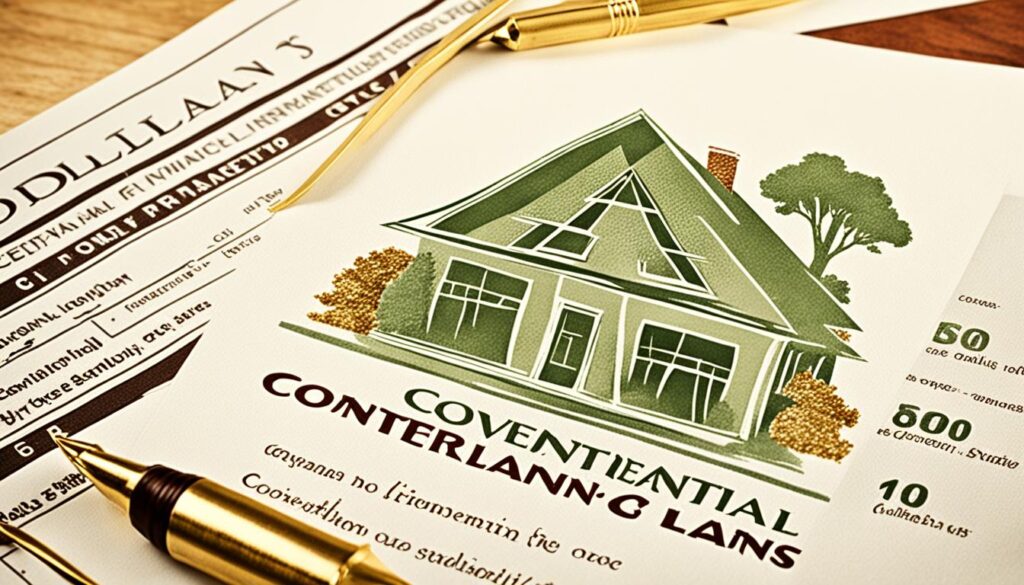Financing your dream home is key, and knowing the types of mortgages helps a lot. Exploring various mortgages is the first step. This way, you can pick the one that suits your needs and finances. Now, let’s dive into different mortgage types to see how they can make homeownership dreams come true.
Key Takeaways:
- There are several types of mortgages, including conventional loans, government-backed loans, jumbo loans, fixed-rate loans, and adjustable-rate loans.
- Choosing the right mortgage depends on factors such as your credit score, finances, and homeownership goals.
- Conventional loans are the most popular type of mortgage and can be used for primary residences, second homes, and investment properties.
- Government-backed loans, such as FHA loans, VA loans, and USDA loans, are insured by federal agencies to make homeownership more accessible.
- Fixed-rate mortgages offer stability with a consistent interest rate and monthly payment throughout the loan term.
Conventional Loans
Many people choose conventional loans for buying homes. These loans are very common and can work for different home-buying goals.
There are two types: conforming and non-conforming loans. Conforming loans follow the Federal Housing Finance Agency’s rules, and big companies like Fannie Mae and Freddie Mac buy them. Non-conforming loans, like jumbo loans, don’t follow these rules.
One good thing about conventional loans is that most lenders offer them. They can help finance your primary home, a second home, or an investment property.
But, when you apply for a conventional loan, your credit score is important. You usually need a credit score of 620 or more to get approved.
The down payment is also key. While you can sometimes put down as little as 3%, it’s better to put down 20%. This way, you won’t need to pay extra for private mortgage insurance (PMI).
To make this info clearer, here’s a summary in a table:
| Conventional Loans | Key Details |
|---|---|
| Types | Conforming Loans (meet FHFA standards) Non-conforming Loans (e.g., jumbo loans) |
| Availability | Available from most lenders for primary residences, second homes, and investment properties |
| Credit Score Requirement | At least 620 |
| Down Payment | Minimum of 3% (20% to avoid PMI) |
Conventional loans offer options and flexibility for buying a home. A good credit score and a solid down payment can help you achieve your dream of home ownership.
Here is an image to further illustrate conventional loans:

Jumbo Loans
Jumbo loans help finance big homes that go beyond normal loan limits. They are for those with special housing needs and require more money. While they offer benefits, there are important rules to follow.

Financing High-Value Homes
Jumbo loans provide money for houses with high prices. They are great for luxury properties or big estates. The set loan minimum may change based on the lender and the market.
Credit Score and Down Payment
Getting a jumbo loan means needing a high credit score. While regular loans might look for a score of 620, jumbo loans need 700 or more. It’s key to have a strong credit history.
Jumbo loans also ask for a bigger down payment. Regular loans can allow 3% to 5% down, but jumbo loans need 10% to 20%. This shows you’re serious about paying back the loan.
Competitive Interest Rates
Surprisingly, jumbo loans can have good interest rates. This is because those who apply are often in a good financial place. But, the rate you get depends on your financial background and market conditions.
Key jumbo loan features include:
| Key Features of Jumbo Loans | Details |
|---|---|
| Loan Amount | Exceeds conforming loan limits |
| Credit Score Requirement | Often 700 or higher |
| Down Payment | Usually 10% to 20% |
| Interest Rates | Competitive, subject to market conditions and borrower qualifications |
Jumbo loans are vital for those aiming to buy dream homes. They open the door to homeownership in places with high-valued homes.
Government-Backed Loans
Want to own a home? Government-backed loans can help by making financing easy. These loans are insured by the government, making them safe for borrowers. Let’s check out FHA, VA, and USDA loans.
FHA Loans

FHA loans help people with low credit scores and small down payments. They’re great for first-time buyers or those on a tight budget. You could get financing with a 3.5% down and a credit score of just 580.
FHA loans make it easier to buy a home, even after money problems. They offer low rates and cover various properties.
VA Loans

VA loans are for military, vets, and their spouses. They don’t need a down payment or PMI. The Department of Veterans Affairs also keeps closing costs low and bans prepayment fees.
USDA Loans

USDA loans are for buying homes in rural areas. They offer 100% financing, meaning no down payment. They have great rates and low insurance costs, perfect for rural homebuyers.
| Loan Type | Down Payment Requirement | Credit Score Requirement | Advantages |
|---|---|---|---|
| FHA Loans | As low as 3.5% | Minimum 580 | Low down payment requirement, flexible qualification criteria |
| VA Loans | No down payment required | N/A, but lenders may have their own requirements | No PMI, favorable loan terms for eligible military members and veterans |
| USDA Loans | No down payment required | Minimum 640 | 100% financing, low mortgage insurance rates |
Government loans open doors to homeownership. From buying your first home to choosing rural life, these loans are here for you. A good lender will guide you through the process, helping you make smart choices.
Fixed-Rate Mortgages
A fixed-rate mortgage is stable and offers peace of mind. The interest rate doesn’t change over the loan term. So, your monthly payment stays the same.
With a fixed interest rate, you won’t worry about interest rate hikes. This is unlike adjustable-rate mortgages, where rates can go up.
For long-term homeowners, this stability is key. You can budget more easily. Plus, there’s no need to stress about sudden payment increases.
Yet, fixed-rate mortgages might cost a bit more over time. Adjustable rates usually start lower but may climb later.
Benefits of Fixed-Rate Mortgages:
- Stable and predictable monthly payment throughout the loan term.
- Protection against rising interest rates.
- Easier budgeting and financial planning.
- Well-suited for long-term homeownership goals.
Think about your financial goals when picking a mortgage. Fixed rates are great for long stays. But, adjustable rates can offer benefits too if you plan to move soon.
Your choice depends on what fits your situation best. A good lender can guide you through the decision process. They’ll help you choose the right path for your finances.
Choosing the right mortgage is vital for a secure future. It’s a big step towards your financial well-being.
Adjustable-Rate Mortgages
An adjustable-rate mortgage (ARM) is a home loan that starts with a low interest rate. This rate changes over time, based on the market. ARMs have lower starting rates and monthly payments than fixed-rate loans.
For a period, maybe a few months to several years, the rate stays low. This is a chance for homeowners to save on payments.
But, the rate can go up after this first period. It’s linked to an index, like LIBOR, plus a margin. So, payments could increase or decrease with the interest rate.
ARMs work well for those selling or refinancing soon. They benefit from the low starting rate. Also, those okay with payments rising might like ARMs.
It’s vital to grasp an ARM’s terms. This includes how long the starting period is, how often rates change, and any limits on rate adjustments. This info matters for picking the right loan for you.
Advantages of Adjustable-Rate Mortgages:
- ARMs start with a lower interest rate than fixed loans, saving you money at first.
- Early payments on ARMs are often less, leaving you with more cash.
- Good for short-term homeownership plans, offering savings in the beginning.
Considerations for Adjustable-Rate Mortgages:
- Later, your interest rate can go up or down, changing your monthly payment.
- Be ready for your payment to shift in line with the market’s rates.
- Think about how you’ll handle payment increases down the line, balancing short-term savings with long-term planning.
“Adjustable-rate mortgages offer an initial lower interest rate and lower monthly payments, making them an attractive option for short-term homeownership plans or for those comfortable with potential payment fluctuations.”
Consider this to understand ARMs:
| Loan Term | Introductory Period | Adjustment Period | Margin | Interest Rate Index | Initial Interest Rate |
|---|---|---|---|---|---|
| 30 years | 5 years | 1 year | 2% | 1-Year Treasury Index | 3% |
In this setup, a borrower picks a 30-year ARM with a 5-year start at 3%. After 5 years, the rate changes based on the 1-Year Treasury Index plus 2%. The first 5 years mean lower payments.
But after this, your rate may increase or decrease each year. If the index rises, so does your rate and payment. If it falls, you may pay less.
Always carefully check an ARM’s terms. Talking to a mortgage expert can guide you. They will help you see if an ARM fits your finances.
Other Types of Mortgages
There are more options than just the big types of mortgages. These alternative mortgage types work for different needs. Let’s look at a few less common ones:
Construction Loans
A construction loan helps those who want to build their home. It gives money to pay for building. Once the home is built, it turns into a regular mortgage.
Interest-Only Mortgages
Interest-only loans mean you pay less each month at first. But, this only covers the loan’s interest. Someday, you must pay the full loan amount.
Piggyback Loans
Piggyback loans split into two to skip mortgage insurance. A smaller loan helps with the down payment. The bigger loan covers most of the home’s cost. Remember, piggyback loans might cost more to close.
Ballon Mortgages
Ballon mortgages start with lower payments. But, a big payment is due at the end. They can work for those with steady incomes ready for a large final payment.
Portfolio Loans
These are loans lenders keep instead of selling. They might be easier to qualify for than other loans.
Renovation Mortgages
These help with buying homes that need fixing up. You get money for buying and renovating. It’s a good way for homeowners to get their dream house.
Learning about different mortgages helps you choose the best one. You might need a new home, lower initial payments, or money for fixes. There’s a mortgage type to fit your specific situation.
Next, we’ll dive into the details to pick the best mortgage for you.
Comparing Mortgage Options
Choosing a mortgage involves comparing various options from different lenders. This allows you to make a choice that fits your financial goals and preferences well. Here’s a guide to help you through this process:
1. Get Pre-Approved for a Loan
It’s a good idea to get pre-approved before comparing mortgages. This means a lender will look at your finances to see how much you can borrow. It gives you a clear price range, making it easier to choose a mortgage.
2. Determine Your Price Range
Being pre-approved lets you know your price range. You’ll find out how much you can borrow based on your income and other financial factors. This knowledge is key for looking at homes within your budget.
3. Compare Terms and Rates
Focus on the loan terms and interest rates when comparing mortgages. Decide if a 15 or 30-year loan is best for you. Also, make sure the interest rates are competitive and fit your budget.
4. Assess Lender Fees and Closing Costs
Don’t forget about fees and closing costs. These include things like origination and appraisal fees. Knowing these costs helps you pick a lender with the best terms and charges.
5. Evaluate Customer Service and Reputation
Customer service and a lender’s reputation matter too. Aim for a lender known for helping their customers and having a good name. Recommendations and reviews can guide you to a lender that offers reliable service.
By following these steps, you can find a mortgage that meets your needs. The loan process also includes steps like submitting documents and filling out an application. Working closely with your lender is crucial for a smooth and successful mortgage process.
Conclusion
Choosing the right mortgage is key for owning a home successfully. By knowing the mortgage types, borrowers can pick what’s best for them. Factors like credit score, down payment, interest rates, and loan terms matter.
Choosing a good lender and having your documents ready make getting a mortgage smoother. The right mortgage helps people reach their dream of having a home.
It’s important to look at all mortgage options and consider their benefits and drawbacks. For instance, conventional loans are flexible and easy to get. Jumbo loans work well for expensive homes. Government-backed loans help some people more, and fixed-rate mortgages give steady payments.
Adjustable-rate mortgages might interest those wanting lower starting rates. There are also specific mortgages for unique situations, like building a new home or fixing up a property.
By doing your homework and comparing offerings, you can find the mortgage that fits you best. The right mortgage sets you on the path to home ownership and financial security.
FAQ
What are the types of mortgages?
The main types are conventional, government-backed, jumbo, fixed-rate, and adjustable-rate loans. Others include loans for building or renovating homes or investing in property.
What are conventional loans?
Conventional loans are a popular mortgage type. They come as either conforming or non-conforming loans. Conforming loans meet Federal Housing Finance Agency standards. Fannie Mae and Freddie Mac purchase these. Non-conforming loans, like jumbo loans, exceed these standards. They are offered by many lenders and suit various property types.
What are jumbo loans?
Jumbo loans finance more expensive homes beyond conforming loan limits. They typically need a higher credit score and a larger down payment. In high-value areas, they might be the sole option and can offer competitive rates.
What are government-backed loans?
These loans are insured by federal agencies, making homeownership more attainable.
FHA loans require lower credit scores and down payments and are insured by the Federal Housing Administration.
VA loans have military benefits and are guaranteed by the Department of Veterans Affairs.
USDA loans help low- to moderate-income buyers in rural areas and are guaranteed by the Department of Agriculture.
What are fixed-rate mortgages?
These mortgages have a steady interest rate and payment for the loan’s life. They make budgeting easier. But, they might cost more in the long run than adjustable-rate loans. They’re ideal for long-term homeowners seeking payment stability.
What are adjustable-rate mortgages (ARMs)?
ARMs begin with a fixed interest rate, then transition to one that can vary. They offer lower initial rates and payments but can change. They’re good for short-term homeowners or those okay with payment changes.
What are the other types of mortgages?
There are further mortgage types, like construction loans that turn into full mortgages. Piggyback loans and interest-only loans offer unique payment options.
Balloon mortgages need a large final payment and are for the financially stable. Portfolio loans from lenders have flexible terms. Renovation mortgages are for buying homes that need repairs.
How do I compare mortgage options?
To choose a mortgage, compare many lenders’ offers. Start by getting pre-approved to know your budget. Then, work with your lender to secure your mortgage when buying a home.


















